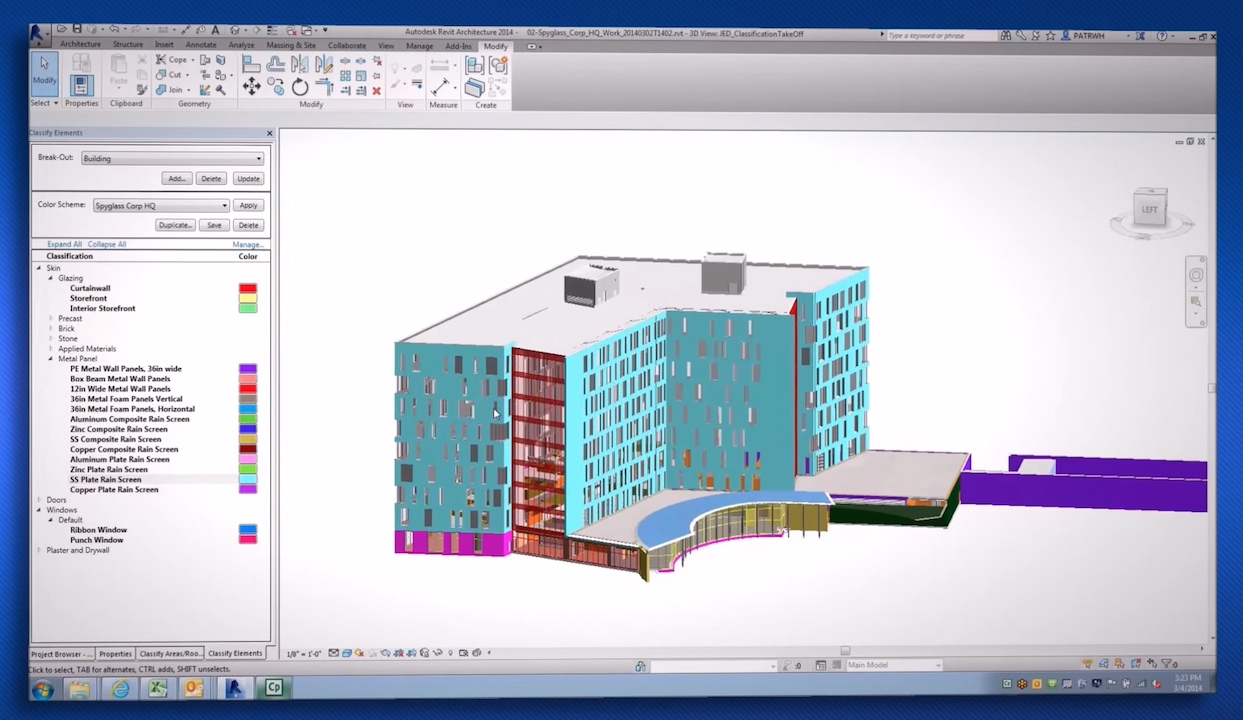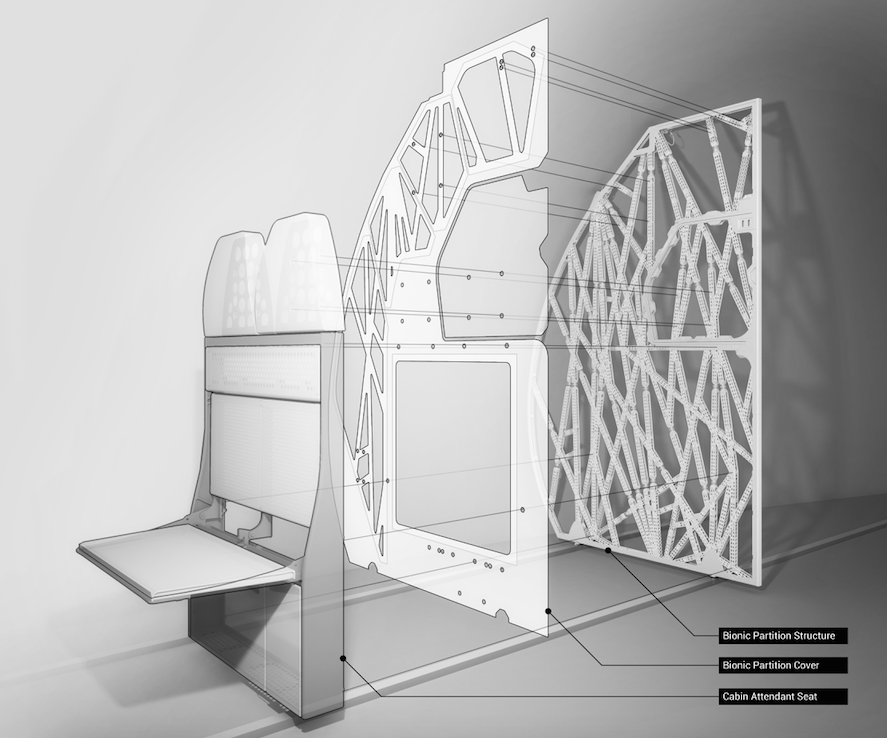The work processes and roles of architects, engineers, and general contractors are continuing to be disrupted by building information modeling and virtual design and construction technologies. Three emerging innovations are representative of the radical change that’s taking place in the commercial construction market.
Model-based Visual Estimation Brings
Real-time Cost Estimating to the Design Phase
Kansas City, Mo.-based general contractor JE Dunn Construction had a great in-house estimating tool at its disposal. Comprising more than 30 years of estimating calculations complied by the firm’s VP of Estimating, Martin Blood, the ATSE system (short for Art To Science Estimating) gave JE Dunn the information and know-how to be able to estimate prices accurately very early in the design process.
ATSE’s pricing engine takes into account design decisions to make sure the contractor has the right price and the building will meet code requirements. It also understands how building systems work together and what impact different decisions have on the installation and operation of those systems.
There was just one problem: JE Dunn couldn’t get designers to use ATSE. They didn’t believe the tool could be that accurate at the conceptual design stage.
 The new tool, JE Dunn Lens, creates a data layer on top of an architect’s BIM model to provide real-time cost estimates.
The new tool, JE Dunn Lens, creates a data layer on top of an architect’s BIM model to provide real-time cost estimates.
“It’s a complex system wherein a very minimal amount of design input leads to a series of trickle-down quantifications based on engineered formulas and, more importantly, on how full systems come together during construction,” says John Jacobs, JE Dunn’s CTO. He says, using ATSE, the firm is able to accurately price (within 5%) projects that are in the napkin-sketch stage. “People never believed this, so we added a visualization element to that pricing model.”
The new tool, JE Dunn Lens, deployed last year, creates a data layer on top of an architect’s BIM model to provide real-time cost estimates. If the design team, for example, adds a floor to the project or changes a piece of MEP equipment, the adjustments are represented in both the estimate and the visual model. The calculations built into the system pull accurate, local prevailing prices for construction products such as rebar and structural steel beams.
“When we can sit with a designer and have a verbal and visual conversation that immediately results in a budget adjustment, that fundamentally changes how a GC and an architect work together,” says Jacobs. “The designer can focus on the owner’s needs and doesn’t have to worry about translating every little detail to something that a GC can use so that they can have a reliable price.”
Lens is currently being used on more than 30 projects across the nation, representing some 300 estimates to date. On one project alone, it was used to deliver 24 estimates in 19 weeks.
Component-Based Structural System
Makes Steel Erection a Snap
ConXtech developed and manufactures a prefabricated, mass-customized, component-based structural steel moment frame and space frame building system. The company’s ConX System reduces the structural frame of a building to a robust “chassis,” made up of HSS or box columns (typically concrete filled), wide-flange beams, and patented interlocking joints. One joint forms a moment connection (a collar), and the other a gravity connection. Building Teams assemble the connections on site by lowering and locking them into place. The process requires virtually none of the “cut-and-fit” or welding that typically takes place in the field, according to the company’s Founder and CEO Bob Simmons.
“The weight and 3D taper of the structural pieces draws them into alignment, and holds them in place,” says Simmons. This design feature eliminates the need for a crane to hold structural members in place at a precise elevation before they are welded.
 The ConXTech system is a moving chassis wherein one joint forms a moment connection, the other a gravity connection. Both connections are assembled by lowering and locking them into place. Courtesy ConXTech. Click photo to enlarge.
The ConXTech system is a moving chassis wherein one joint forms a moment connection, the other a gravity connection. Both connections are assembled by lowering and locking them into place. Courtesy ConXTech. Click photo to enlarge.
“Typically, the crane operator is engaged, holding it at elevation, while an ironworker is sticking a tapered pin in to hold it at alignment and then a bolt to fix it into place before welding,” Simmons explains. “Our system is intended to make the work more efficient and safer.”
ConXtech can take any 3D model, whether from a 3D BIM program or something as simple as 2D AutoCAD, import it into its ConXCAD application and convert the geometry into a set of wireframe parametric components, which will eventually be erected by the chassis system. The wireframe drives everything from manufacturing to installation. The time savings can be dramatic.
For example, a ConX steel frame and concrete-over-metal-deck structural system for Kaiser Permanente’s 64,700-sf, three-story medical office building in San Mateo, Calif., was fabricated and erected in less than eight weeks—four weeks for fabrication, six-and-a-half days for steel assembly, and three weeks to complete the deck. The process, led by DPR Construction, maximized full coordination with subcontractors.
“All buildings, when you’re framing, have columns and beams,” says Simmons. “We had to become more modular. The point was to use those interconnections. If we can use the extra capacity in the columns and beams and hook them together with a rigid connection, then we have a more efficient structural solution.”
Airbus Uses Generative Design and
3D Printing to Reinvent Airplane Interiors
David Benjamin, Principal with the design practice The Living, has been exploring generative design for years. The process employs computing power to generate, evaluate, and evolve thousands of design options that can meet the goals of the project. It also uncovers new design possibilities through the inherently iterative process.
When aircraft giant Airbus saw some of Benjamin’s generative design work at the Autodesk Gallery in 2011, it started a multiyear project to create the first generatively designed aircraft partition for the Airbus A320.
The “bionic” partition is 3D-printed from a direct metal laser sintering (DMLS) printer that uses a new rare earth metal alloy, called scalmalloy, to achieve the lightness of aluminum with the strength of titanium.

 The web-like partition is stronger and as much as 55 pounds lighter than current systems.
The web-like partition is stronger and as much as 55 pounds lighter than current systems.
Using the generative design process, Benjamin’s team developed a web-like partition that is stronger and as much as 55 pounds lighter than current systems. The design is incredibly efficient, using a minimal amount of the metal alloy. It’s also redundant: the structure can hold its own weight if one or more of the nodes are compromised. The 122 parts that make up the partition are printed in seven batches.
If the partition passes final testing, Airbus intends to install it in every new A320. Benjamin says the move will remove 96,000 tons of CO2 a year, thanks to less jet fuel being burned to transport the heavier legacy partitions.
“I think this was, in many ways, a demonstration project for advanced metal 3D printing as well as for generative design and its possibilities,” says Benjamin.
As manufacturing and building delivery draw ever closer, projects like this one, which utilize the latest advancements in computational design and 3D printing, show what’s possible for Building Teams that embrace the latest technologies.
Related Stories
| Apr 23, 2014
Ahead of the crowd: How architects can utilize crowdsourcing for project planning
Advanced methods of data collection, applied both prior to design and after opening, are bringing a new focus to the entire planning process.
Sponsored | | Apr 17, 2014
Technology enables state transportation agency to make the leap to digital design review
Earlier this month, my colleague and I presented a session to a group of civil engineers and transportation agencies about the tech trends in the AEC space. Along with advice on how to prepare your plan for controlled collaboration, we also talked through some practical use cases. One such use case was especially interesting, as it outlined a challenge not unfamiliar to government agencies who are contemplating the leap from paper to digital processes: how to securely migrate workflows.
| Apr 10, 2014
Submit Your Project for a Bluebeam eXtreme Award!
Bluebeam is holding the second annual Bluebeam eXtreme Awards at the 2014 Bluebeam eXtreme Conference in Hollywood, Calf.
| Apr 3, 2014
Security, accountability, and cloud access: Can you really have it all?
I’ve heard countless stories of conversations between project engineers and IT professionals who can’t come to an agreement on the level of security needed to protect their data while making it more accessible—not only externally, but also internally.
| Apr 2, 2014
New Autodesk software allows visualization of more realistic bridge concepts
The Autodesk InfraWorks 360 family of offerings now includes enhanced roads and highways capabilities, better representations of graphical information, and fixed-length pipe modeling capability.
| Mar 26, 2014
Zaha Hadid's glimmering 'cultural hub of Seoul' opens with fashion, flair [slideshow]
The new space, the Dongdaemun Design Plaza, is a blend of park and cultural spaces meant for the public to enjoy.
| Mar 20, 2014
Fluor defines the future 7D deliverable without losing sight of real results today
A fascinating client story by Fluor SVP Robert Prieto reminds us that sometimes it’s the simplest details that can bring about real results today—and we shouldn’t overlook them, even as we push to change the future state of project facilitation.
| Mar 12, 2014
New CannonDesign database allows users to track facility assets
The new software identifies critical failures of components and systems, code and ADA-compliance issues, and systematically justifies prudent expenditures.
| Mar 10, 2014
Meet Tally – the Revit app that calculates the environmental impact of building materials
Tally provides AEC professionals with insight into how materials-related decisions made during design influence a building’s overall ecological footprint.
| Mar 10, 2014
Field tested: Caterpillar’s Cat B15 rugged smartphone
The B15 is billed by Cat as “the most progressive, durable and rugged device available on the market today.”
















